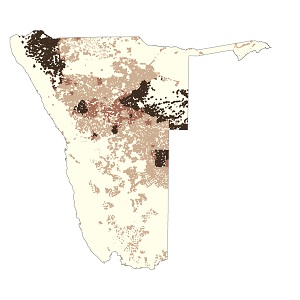Languages spoken in Namibia
9.14 Distribution of major languages and dialects, 201127
Afrikaans

English

German

Khoekhoegowab

Oshikolonkadhi

Oshikwaluudhi

Oshikwambi

Oshikwanyama

Oshimbadja

Oshimbalantu

Oshikolonkadhi

Oshindonga

Oshingandjera

Otjiherero

Rugciriku

Rukwangali

Rushambyu

Setswana

Sifwe

Silozi

Sisubiya

Siyeyi

Thimbukushu

Totela

Despite its relatively small population, Namibia is home to a surprising number of languages and dialects. Three categories of language presence are shown in these maps: areas where the language is present in a minority (less than 33 per cent) of households; areas where the language is commonly spoken (33–66 per cent of households); and areas where the language is spoken in the more than 66 per cent of households in a census enumeration area. These data, collected during the 2011 population and housing census, also showed that five languages were predominant and most commonly spoken in Namibian households: Otjiherero, 9.7 per cent; Afrikaans, 10.3 per cent; Khoekhoegowab, 11.3 per cent; Oshindonga, 15.1 per cent; and Oshikwanyama, 21.2 per cent of households.
Although English is the official language of Namibia, it was not the language spoken in most households in 2011. As can be seen from the maps, Otjiherero (and its dialects), Oshikwanyama, Oshindonga, Rukwangali, Khoekhoegowab and Afrikaans were spoken most widely across Namibia. Other major languages taught in schools include English, German, Ju|'hoansi, Rumanyo, Setswana, Thimbukushu and Silozi.28
In general, multiple dialects are found within certain languages. Seventeen languages in the northern regions predominate in small areas strung along the northern border from east to west. This profusion in the northern areas is associated with crop production and the consequent development of smaller, sedentary societies, each with its own leadership and language. Afrikaans, English and German are spoken widely and commonly in urban areas.
The map of Khoekhoegowab speakers covers the distribution of three peoples: Nama in the southern half of Namibia, Damara in the western-central areas and Haiǁom south and east of Etosha National Park. Both Haiǁom and Damara people are considered to have switched to speaking Khoekhoegowab dialects from !Kung (also known as !Xung or Sekele) and Otjiherero languages, respectively.
» View/download map - Afrikaans (jpg)
» View/download map - English (jpg)
» View/download map - German (jpg)
» View/download map - Khoekhoegowab (jpg)
» View/download map - Oshikolonkadhi (jpg)
» View/download map - Oshikwaluudhi (jpg)
» View/download map - Oshikwambi (jpg)
» View/download map - Oshikwanyama (jpg)
» View/download map - Oshimbadja (jpg)
» View/download map - Oshimbalantu (jpg)
» View/download map - Oshindonga (jpg)
» View/download map - Oshingandjera (jpg)
» View/download map - Otjiherero (jpg)
» View/download map - Rugciriku (jpg)
» View/download map - Rukwangali (jpg)
» View/download map - Rushambyu (jpg)
» View/download map - Setswana (jpg)
» View/download map - Sifwe (jpg)
» View/download map - Silozi (jpg)
» View/download map - Sisubiya (jpg)
» View/download map - Siyeyi (jpg)
» View/download map - Thimbukushu (jpg)
9.15 Distribution of six languages spoken by San people in Namibia29

Because San people are generally widely and sparsely distributed, the presence of their languages is not as prominent as the more commonly spoken languages (figure 9.14). Other San languages are spoken elsewhere, and they collectively form part of the Khoesan (also spelt Khoe-Sān) language family, of which Khoekhoegowab is a member.

